

Samsung's latest QLED TV tested: The LCD empire strikes back
The Q9FN is a little thick. And that's about the only negative thing I can say about Samsung's latest QLED TV. Because it sets new standards in the LCD sector.
Rey and Ben from "Star Wars: The Last Jedi" fight their way through numerous elite guards clad in shimmering red armour. Sparks fly as lightsabres clash with electric whips and halberds. In dark areas of the picture, black actually looks like black. John Williams' score, which booms impressively from the 60-watt TV speakers, casts a spell over me.
Yes, the new QLED from Samsung is a true revelation.
LCD vs OLED: What has happened so far
In the last ten years, the TV industry has seen the rise and fall of plasma TVs, the meteoric boom of OLED technology and, somewhere above it all, the plodding but unstoppable LCD technology. LCD TVs in particular have been so slow to make real progress that they have often felt like evolutions rather than innovations.
It is the technology with the organic light-emitting diodes, namely OLED, that is probably Samsung's biggest concern in the high-end sector. According to GfK, OLED televisions in the upper price segment - from around two thousand francs upwards - were already selling better than LCD televisions last year.
It is obvious that Samsung would like a slice of this revenue pie. And that nothing will come of it in the near future. After all, the company's own OLED developments had to be discontinued years ago following various failures and technical problems. However, the South Koreans did not back down. A year ago, they developed their own LCD-based display technology for the premium market in the form of "QLED TVs", which are said to be on a par with OLED picture quality.
Now I'm sitting there, in my flat, in front of Samsung's latest QLED TV. Incidentally, it's deliberately here and not in some sealed-off room under perfect laboratory conditions. You want the telly to look good in your flat, not in the lab. Because the sun sometimes shines in here. I like going to the cinema in the evening, but what about an afternoon football match during the World Cup? And how good are my UHD Blu-rays? All important questions that I'm looking for answers to. And the test begins.
Smart Home and flawless installation
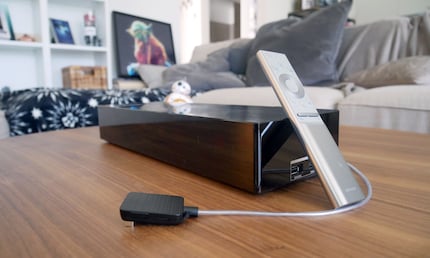
An hour before. The Samsung technicians have just brought the TV to me and installed it. They also brought a soundbar, a robot vacuum cleaner and a smartphone. All Samsung branded, of course. They want me to test the extent to which the new QLED TV fits into Samsung's smart home concept.
This concept involves me doing things like starting the robot vacuum cleaner from the TV or having my tumble dryer send a pop-up message to the QLED as soon as my Gryffindor socks are dry. If I had a Samsung fridge, I could even look into the fridge from the TV via an installed camera to see what I should get to eat next.
Yes, the possibilities are endless, the SmartThings app works and the technology is impressive. But I can't get rid of the image of fat, lazy people from "Wall-E". Maybe that's why I don't really want to use all the smart home functions. That's what I thought at the Samsung launch event in April.
On the other hand, the initial installation of the QLED is extremely easy and the One Connect Box gets a small update.
The box was already available for the 2017 QLEDs. It contains all connections such as HDMI port, USB input and LAN socket. What's new is that the TV gets its power directly from the One Connect Box. This eliminates the need for a separate power cable for the TV, which made the separate box absurd last year. Back then, the South Koreans boasted of an invisible cable to make the TV look as if it was floating on the wall. Nobody mentioned the power cable, which was anything but invisible.
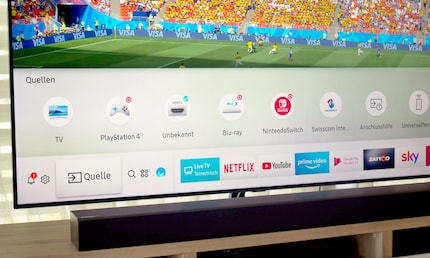
Once everything is plugged in, the QLED TV recognises the connected devices, whether Blu-ray player, games console or set-top box. I can select the devices more easily in the Smart TV menu and even operate some of them using the remote control supplied by Samsung. The only thing the TV doesn't really want to recognise is my Swisscom TV box. Nevertheless: I really like this much user-friendliness.
Probably the best LCD TV there is
Back to "Star Wars". Meanwhile, the evil First Order is laying siege to the resistance base on the planet Crait. Blood-red clouds of dust - actually minerals under a layer of white salt - trail behind the skispeeders like clouds of condensation. The resistance fighters daringly throw themselves into the fight.
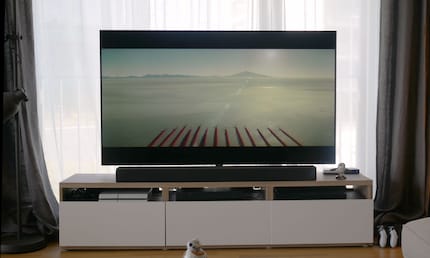
I am surprised at how many fine details I can recognise in the almost blindingly bright image. The pulsating red of the dust clouds never looks pale, which would be typical with so much brightness. I watch the glistening sun, which stands out clearly against the steel-blue sky above Crait, with enthusiasm. Although the camera follows the action at a monkey's pace, I never notice any streaks or motion blur in the picture. Incidentally, this generally applies to fast action scenes: The Q9FN has motion blur just as well under control as Sony's OLED A1 or AF8.
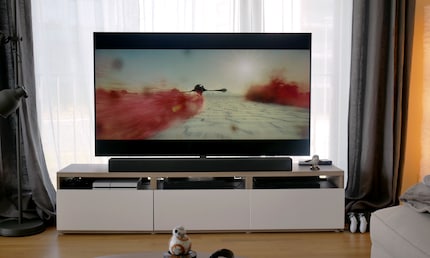
When the legendary Jedi warrior Luke Skywalker enters the battlefield, the contrast of the scenery almost knocks my socks off. And the simultaneous colour depth - i.e. the number of colours an image can contain - is impressive, both in the brightest and darkest parts of the image. No detail is lost. The dust clouds, coloured a lush orange-red by the sun, rise majestically around the landing spaceship, while Luke's black silhouette stoically confronts the evil.
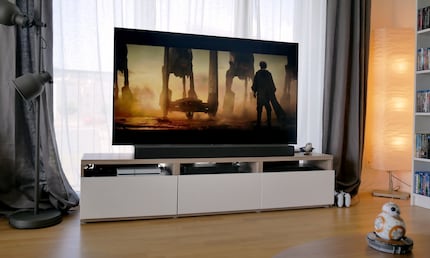
This is pure cinema magic. Especially for an LCD television. The closest I've seen to such natural and rich colours with such large differences in brightness are the two Sony models XF9005 and ZD9. Both use the same backlight technology as the Q9FN. The only difference is that the Q9FN outshines them. Quite clearly, in fact.
New on board: full array and local dimming
At around 2.5 centimetres, the panel is around two centimetres thicker than LG's OLED competition, and a little thicker than all other 2018 QLED models.
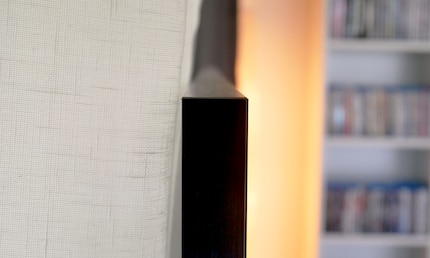
There is a good reason for the width, which is rather on the upper limit for 2018: Samsung has given the Q9FN full array and local dimming backlighting, or FALD for short, as the only QLED model ever. I would like to briefly explain this term to you, because it is important.
In LCD TVs, the light that makes the pixels glow comes from edge LEDs located in the edge of the pixel display. They shine onto the picture from the side. A plastic film between the LEDs and pixels ensures that the light is distributed evenly across the entire panel. Full array basically just means that the TV has many more LEDs than conventional LCD televisions. The highlight: they are not located on the side, but directly behind the pixels. This inevitably makes the TV slightly thicker, but the pixels are illuminated much more precisely than by LEDs shining in from the side.
The full-array LEDs cannot illuminate each of the more than eight million pixels with pinpoint accuracy, but they divide the screen into around five hundred localised zones. Each zone can be switched on and off independently of the others.
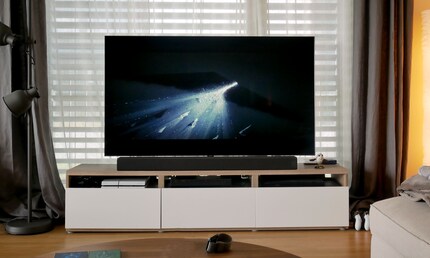
Top: Vice Admiral Holdo tears apart the Supremacy - the mega star destroyer of evil Supreme Leader Snoke - by flying a Resistance star cruiser - the Raddus - straight through it at hyperspace speed.
Behind the bright explosions, the LEDs are shining at full steam, but behind the dark vacuum of space, the energy is only slowed down. The black levels almost reach OLED levels, although small areas of the image are shrouded in glaring light. It's actually crazy that I can't tell whether it's an OLED or LCD screen until I'm standing two metres in front of the TV. I'm not used to that. Normally, I can quickly recognise what I'm looking at - even from the far corner of my wide kitchen. Not here. This is precisely the strength of Full Array and Local Dimming.
In tandem with Quantum Dot technology, Samsung's QLED TVs are able to display an unprecedentedly wide colour spectrum, even at brightness levels of 2000 nits - which Samsung claims the Q9FN achieves. This is because when the LEDs on other LCD TVs run under full load, the colours literally fade.
Away from UHD and HDR
The film is over and I'm satisfied. It's time to look at other source material. I quickly realise that the QLED is also convincing away from UHD and HDR material. The processor built into the TV is responsible for this.
Picture processors are there to calculate and improve video signals from the tuner or other input channels such as HDMI or LAN. For example, if you are watching a TV programme in Full HD and it is upscaled to Ultra HD resolution.
So I'm trying it out with live TV. I get it via the internet from my Swisscom TV box. Samsung's Q9FN handles upscaling very well on all the channels I tried. It adds detail without amplifying noise or other interference in the signal source. Edges are smoothed sensibly and colours are enhanced naturally.
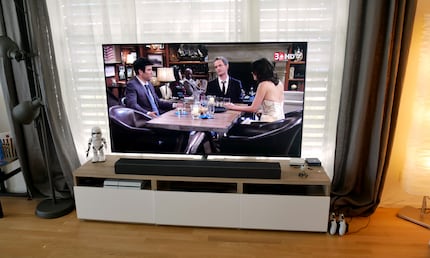
Again, I'm sure this is the best image processing technology I've seen in a long time. Compared to the competition, I'd only put Sony's A1 or LG's C8 a small notch above it. However, the difference is barely visible to an untrained eye.
I love streaming YouTube content to the TV. You should try that too, if you're not already doing it. With the Q9FN, the colours remain balanced even without UHD HDR material and there are no unsightly streaks when the camera pans quickly. Particularly commendable: the black levels, which only just miss the OLED level, are also available here.
Gaming: I only played my favourite hate game Fifa in game mode when I wanted to beat a few naive amateurs online. External reports measure an input lag of just 15 milliseconds, which is very little for TVs. However, the picture has little edge smoothing and the colours appear overdrawn in places. I liked the game mode of the C8 much better, even if the input lag is a little higher at 20-25 milliseconds.
HLG and the future of live TV
Samsung's Q9FN naturally also supports HLG - an HDR technology that is particularly suitable for live TV. I recently wrote about it.
Because Swisscom TV broadcasts SRG's UHD HDR signal, I was able to get a first impression of what the future of live TV could look like. Curious: Swisscom has opted for the HDR10 signal for the World Cup broadcast. HLG is still not widespread enough, as I learnt in a statement from media spokeswoman Sabrina Hubacher. In future, however, an HLG signal will be used for live content and an HDR10 signal only for video-on-demand.
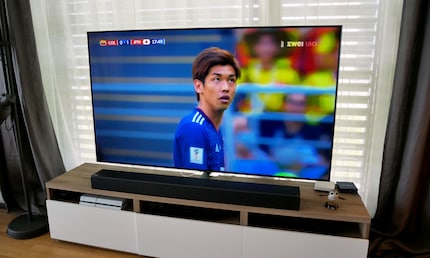
There were no stutters or streaks in the high-calibre match between Japan and Colombia - even on ORF's Full HD picture quality. This speaks in favour of the TV's good response time.
Ambient mode: a nice addition
A brand new feature of Samsung's Q9FN is Ambient Mode. Put simply, this is the art mode familiar from the Frame series - but without the art.
The idea is to prevent your QLED TV from looking like a huge black hole when it's switched off. That's what Ambient mode is for. This shows pre-installed or customised images, the time, current weather, outside temperatures or headlines. Depending on the brightness, which you can set yourself, the mode consumes between 60 and 80 watts, i.e. around thirty to forty per cent of the usual energy consumption. Finally, you can use a timer to define when the TV should switch off completely.
But the most exciting feature of Ambient Mode is that you can imitate the wall behind your QLED TV as if you were looking directly through it. To do this, you need the SmartThings app on your smartphone to take a photo of the wall.
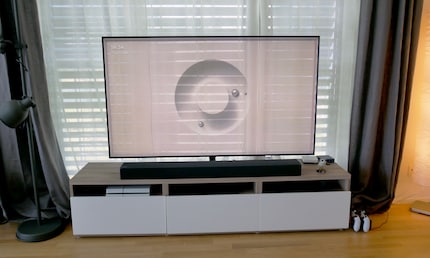
In the beginning, I found the ambient mode quite funny. But because my TV is in front of a living room window, there's about half a metre of space between the TV and the window. So as soon as I'm no longer looking at the TV head-on, the illusion is lost.
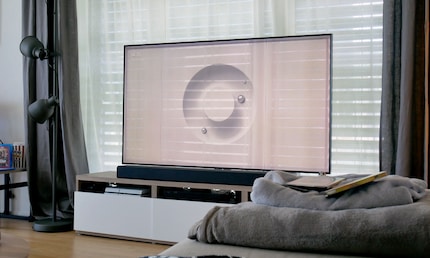
This was also the reason why I practically never made use of Ambient Mode. In future, however, this will be "the way to go" - I'm sure of it. Because Samsung is not the only manufacturer that has realised that televisions sell better when they are also marketed as lifestyle products.
Conclusion: The Q9FN takes on the latest OLEDs
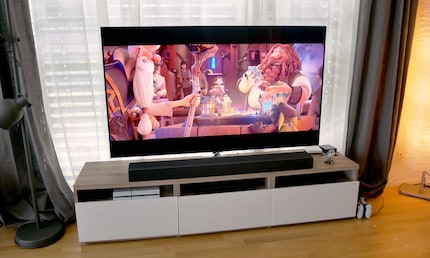
QLED is Samsung's LCD technology that is supposed to give OLEDs a run for their money. Well, the technology is not yet on a par. Unless you take the Q9FN as a comparison model, because it is Samsung's only QLED with Full Array and Local Dimming: only the combination of "FALD" and the Quantum Dots ensures such great black levels and balanced colour reproduction with high brightness values. In this domain, no other TV can really hold a candle to the Q9FN.
However, the televisions with organic light-emitting diodes have the edge in darker picture areas. They show more details and at the same time an ingenious colour fidelity. In general, the QLED picture still lacks that certain "punch" that I feel with an OLED - no matter how bright it is in my living room.
I write about technology as if it were cinema, and about films as if they were real life. Between bits and blockbusters, I’m after stories that move people, not just generate clicks. And yes – sometimes I listen to film scores louder than I probably should.


